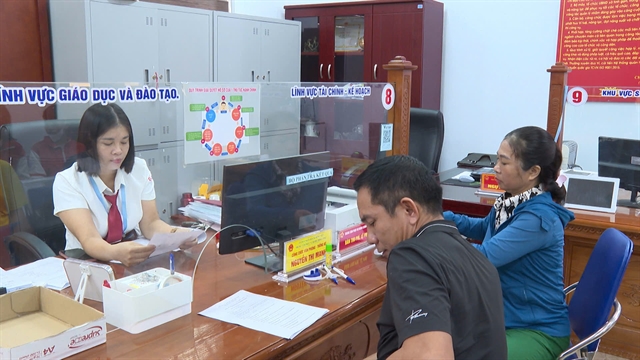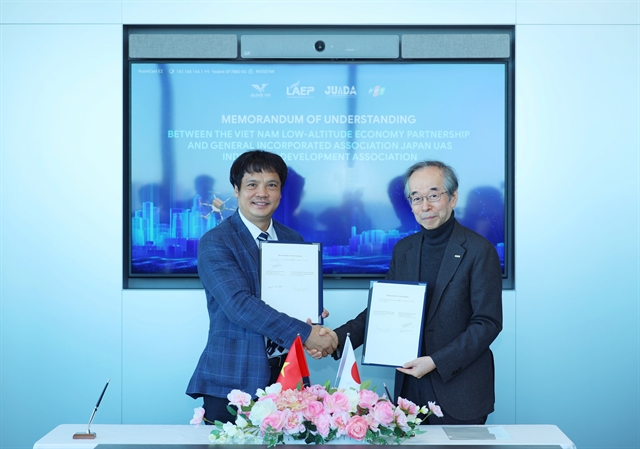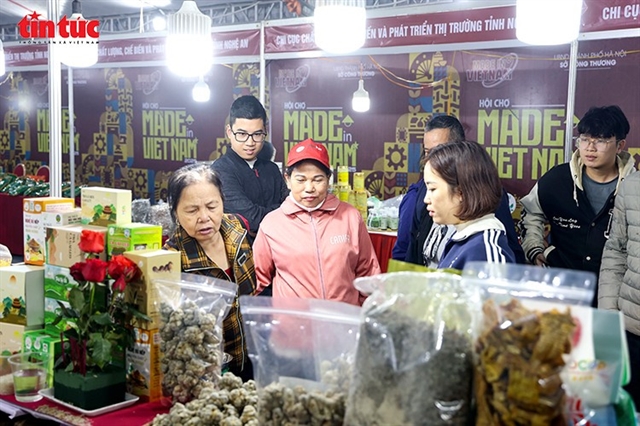 Economy
Economy

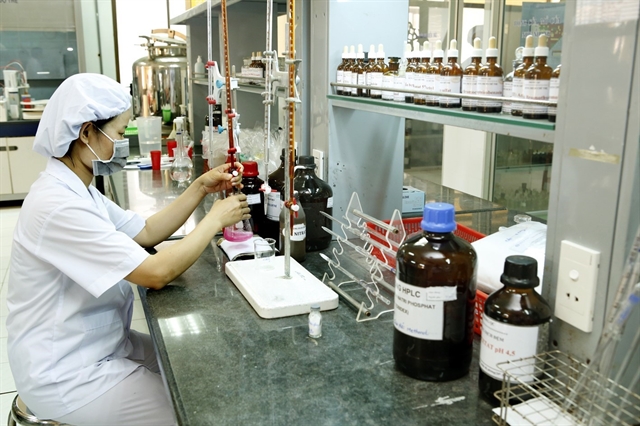 |
| Medicine production at Bình Định Pharmaceutical and Medical Equipment JSC. With the UKVFTA, Việt Nam has significant opportunity to attract FDI from the UK in the pharmaceutical industry, especially in the context that the Vietnamese Government was striving to improve the regulations to create a better investment climate. — VNA/VNS Photo |
HÀ NỘI — The UK – Việt Nam Free Trade Agreement (UKVFTA), together with other new-generation trade deals, were providing significant opportunities for Việt Nam to attract foreign direct investment (FDI) into the pharmaceutical industry, especially in the context that Việt Nam was underway to improve the legal framework with the desire to become a regional centre for pharmaceutical production.
The pharmaceutical sector of Việt Nam was considered to have large potential for growth, driven by the country’s rapid growing middle class, the demand for healthcare services and the Government’s efforts to improve regulations and infrastructure in the sector, especially after the COVID-19 pandemic, according to a report of Vietdata.
Consulting firm Dream Incubator (DI) said in a report about the industry that Việt Nam had more room for future growth, given the low average of pharmaceutical spending per capita, compared to neighbouring economies,
Market research firm IBM predicted that the pharmaceutical industry might reach a size of $16.1 billion in 2026, from $7.7 billion registered in 2021.
According to Fitch Solutions, pharmaceutical spending per capita of Việt Nam would reach a compound annual growth rate of 7.8 per cent in 2022-26 period, from VNĐ1.46 million in 2021 to VNĐ2.21 million in 2026, accounting for around 5 per cent of the country’s income per capita.
Although the market in recent years has seen acquisitions of local pharmaceutical manufacturers by foreign drug companies, the FDI flow into the sector remained modest compared to the potential of the market of about 100 million, according to Vietdata's 2022 Pharmaceutical Industry Report.
The report pointed out that Việt Nam’s production capacity could only meet 53 per cent of the country’s pharmaceutical demand. Figures from the General Statistics Office showed that Việt Nam spent nearly $4 billion importing pharmaceuticals in 2021.
Đỗ Văn Sử, Deputy Director of the Việt Nam Foreign Investment Agency (FIA) under the Ministry of Planning and Investment, said that at a workshop on a new approach to developing the pharmaceutical and healthcare industry held in July that there were many incentives for investment in this sector, but the inflow remained modest.
FIA’s statistics showed that total FDI in pharmaceuticals was estimated at approximately $5.5 billion in 341 projects, accounting for a mere 1.3 per cent of the total registered FDI in Việt Nam.
The figure indicated that the pharmaceutical industry was largely underfunded, given the size of the Vietnamese economy, Sử said.
Sử pointed out that slowness in innovation, barriers in market entry, and bottlenecks related to bidding, pharmaceutical products control, product declaration, registration and testing were among problems which were hindering investments into the industry.
He added that although many foreign enterprises expressed their desire to invest in pharmaceutical enterprises in Việt Nam, they faced barriers in the divestment process and asset evaluation when investing in State-owned companies.
Opportunities from UKVFTA
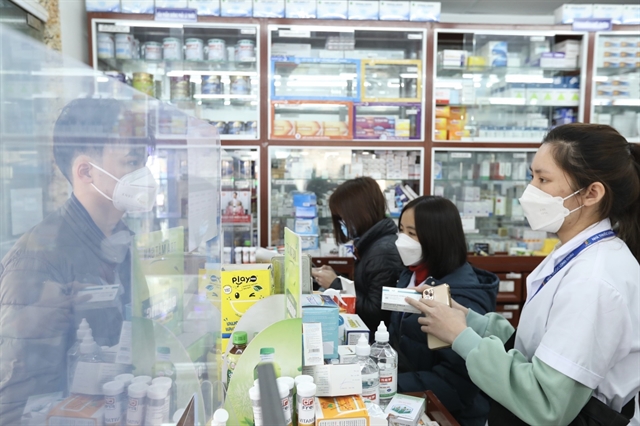 |
| A pharmacist providing information to a customer. Pharmaceutical spending per capita of Việt Nam would reach a compound annual growth rate of 7.8 per cent in the 2022-26 period. — VNA/VNS Photo |
According to Emin Turan, chairman of Pharma Group, Việt Nam had competitive advantages in attracting FDI in pharmaceuticals compared to other countries in the region, including stable politics and social infrastructure, robust economic development and potential domestic market as well as the country’s rapid integration through the participation in about 15 free trade agreements (FTAs), including the UKVFTA.
The Vietnamese Government also placed the biological industry focusing on genes, pharmaceuticals and biological products in the list of key industries to implement Resolution NO 29-NQ/TW on continuing to promote industrialisation and moderninsation by 2030, which was paving the way for the pharmaceutical industry to grow.
The UKVFTA’s commitments and the Vietnamese Government’s efforts in improving the legal framework, especially amending the Law on Pharmacy 2016, were expected to unlock more opportunities for enterprises from both sides in investing in the pharmaceutical industry and promoting trade exchange in the field, experts said.
According to a publication of the UK Department for International Trade, the UKVFTA has secured easier access to UK’s high–quality innovative drugs for Vietnamese importers, with more than 71 per cent of UK pharmaceutical products enjoying tariff elimination immediately, on January 1, 2021. The remainder will be eliminated after 4-9 years.
Specially, under the UKVFTA, Việt Nam would allow foreign pharmaceutical companies to establish foreign–invested enterprises for imports of authorised pharmaceuticals, together with increased access to the public procurement market for pharmaceutical products in Việt Nam.
The publication also pointed out that improvements in intellectual property rights also made Việt Nam an attractive market for producers of pharmaceutical products and enabled better access to qualified medicines for the population.
Việt Nam would also maintain a set-aside scheme for pharmaceuticals, which meant that the market share reserved for domestic suppliers would gradually scale back to a final share of 50 per cent from 2016.
Another commitment was that Việt Nam would withdraw existing clinical trials requirements that were not in line with international standards.
The UK was already Việt Nam’s 9th largest supplier of pharmaceutical products and pharmaceutical products were the most exported goods from the UK to Việt Nam.
The commitments under the UKVFTA created meaningful opportunities for UK pharmaceutical manufacturers and exporters to enter and expand in the Vietnamese market, the publication said, indicating that Việt Nam had a significant opportunity to attract FDI from the UK in the pharmaceutical industry, especially in the context that the Vietnamese Government was striving to improve the regulations to create a better investment climate.
Solutions
Deputy Minister of Health Đỗ Xuân Tuyên said that the ministry was reviewing the Law on Pharmacy 2016 for amendments towards attracting foreign investment in pharmaceutical production, especially of patent medicine, specialised drugs, vaccines, generic drugs and reference biological medicinal products.
Việt Nam was an attractive destination for investments in the pharmaceutical sector, he said, adding that there were huge opportunities for Vietnamese enterprises to receive technology transfer from the UK.
The focus would be placed on improving the mechanism and regulations to enable enterprises from both countries to be able to seize opportunities provided by the bilateral trade deal, he said.
A number of large pharmaceutical corporations were eyeing investment and cooperation opportunities in Việt Nam.
Recently, AstraZeneca, British largest pharma firm, earlier this year worked with HCM City People’s Committee on strengthening cooperation with the ambition of building an innovation centre for science and health in Việt Nam.
In mid-August, AstraZeneca Việt Nam signed a cooperation agreement with a Vietnamese firm on oncology distribution which aimed to improve access to innovative medicines for patients in Việt Nam but also strengthen the capacity of domestic pharmaceutical distributors and consolidate the sustainability of the supply chain.
The cooperation was expected to promote the comprehensive development of Việt Nam’s pharmaceutical industry and contribute to the implementation of the national strategy on pharmaceutical industry development and the UKVFTA.
Deputy Minister of Planning and Investment Nguyễn Thị Bích Ngọc, it was a good idea to form industrial clusters and parks specialised in pharmaceutical production to attract FDI into this sector and turn Việt Nam into a regional centre for pharmaceutical production.
Dương Thị Mai Hoa from Việt Ấn Law Firm said that Việt Nam should learn from the experiences of countries with developed pharmaceutical industries based on foreign investment such as Singapore and the Republic of Korea on the formation of pharmaceutical research and production centres.
As technology transfer was an unavoidable development trend in the pharmaceutical industry, Việt Nam needed to improve the regulations on technology transfer, intellectual property and medicine price management to encourage investment of foreign pharmaceutical companies in Việt Nam and promote technology transfer, he said.
There were 228 factories granted good manufacturing practices (GMP) in Việt Nam, according to statistics of the Ministry of Planning and Investment.
The UKVFTA, in effect from May 2021, marked an important milestone in the economic and trade cooperation between the two countries.
Statistics of the Việt Nam Foreign Investment Agency showed that as of the end of 2022, the UK was the fifteenth largest investor in Việt Nam with a 507 valid projects, worth nearly $4.2 billion. — VNS

